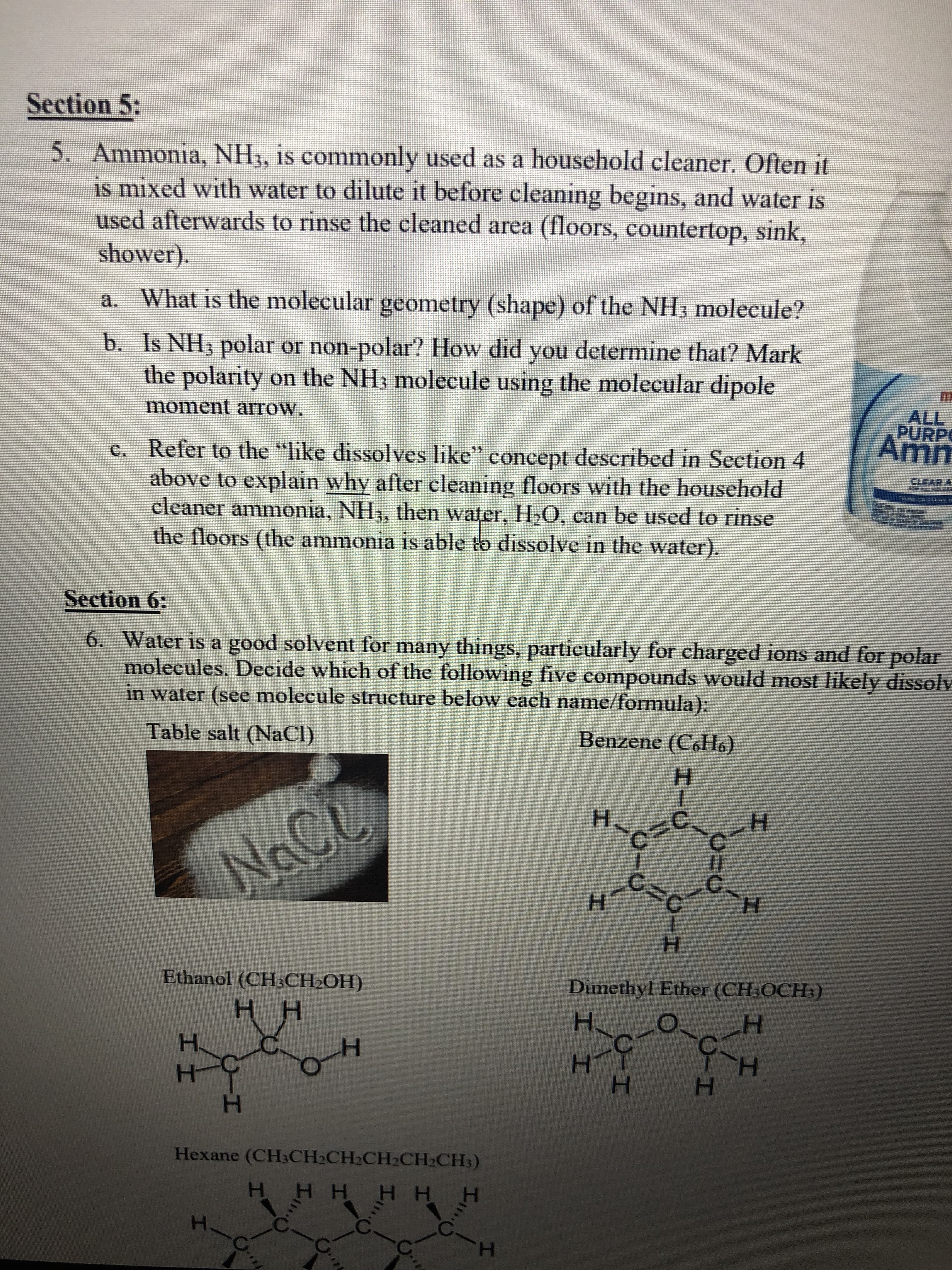Section 5: 5. Ammonia, NH3, is commonly used as a household cleaner. Often it is mixed with water to dilute it before cleaning begins, and water is used afterwards to rinse the cleaned area (floors, countertop, sink, shower). a. What is the molecular geometry (shape) of the NH3 molecule? b. Is NH3 polar or non-polar? How did you determine that? Mark the polarity on the NH3 molecule using the molecular dipole ALL PURPO moment arrow. c. Refer to the "like dissolves like" concept described in Section 4 above to explain why after cleaning floors with the household cleaner ammonia, NH3, then water, H,0, can be used to rinse the floors (the ammonia is able to dissolve in the water). CLE ARA Section 6: 6. Water is a good solvent for many things, particularly for charged ions and for polar molecules. Decide which of the following five compounds would most likely dissolv in water (see molecule structure below each name/formula): Table salt (NaCl) Benzene (C6H6) н H-czċ. H. NaCe H. H. н Ethanol (CH3CH2OH) Dimethyl Ether (CH3OCH3) нн н. н H. H. H. Hexane (CH3CH2CH2CH2CH2CH3) н НН Нн н C.. H. CIH CIH CIH Sい
Section 5: 5. Ammonia, NH3, is commonly used as a household cleaner. Often it is mixed with water to dilute it before cleaning begins, and water is used afterwards to rinse the cleaned area (floors, countertop, sink, shower). a. What is the molecular geometry (shape) of the NH3 molecule? b. Is NH3 polar or non-polar? How did you determine that? Mark the polarity on the NH3 molecule using the molecular dipole ALL PURPO moment arrow. c. Refer to the "like dissolves like" concept described in Section 4 above to explain why after cleaning floors with the household cleaner ammonia, NH3, then water, H,0, can be used to rinse the floors (the ammonia is able to dissolve in the water). CLE ARA Section 6: 6. Water is a good solvent for many things, particularly for charged ions and for polar molecules. Decide which of the following five compounds would most likely dissolv in water (see molecule structure below each name/formula): Table salt (NaCl) Benzene (C6H6) н H-czċ. H. NaCe H. H. н Ethanol (CH3CH2OH) Dimethyl Ether (CH3OCH3) нн н. н H. H. H. Hexane (CH3CH2CH2CH2CH2CH3) н НН Нн н C.. H. CIH CIH CIH Sい
Chemistry & Chemical Reactivity
9th Edition
ISBN:9781133949640
Author:John C. Kotz, Paul M. Treichel, John Townsend, David Treichel
Publisher:John C. Kotz, Paul M. Treichel, John Townsend, David Treichel
Chapter20: Environmental Chemistry-earth's Environment, Energy, And Sustainability
Section: Chapter Questions
Problem 3PS
Related questions
Question
5 c

Transcribed Image Text:Section 5:
5. Ammonia, NH3, is commonly used as a household cleaner. Often it
is mixed with water to dilute it before cleaning begins, and water is
used afterwards to rinse the cleaned area (floors, countertop, sink,
shower).
a. What is the molecular geometry (shape) of the NH3 molecule?
b. Is NH3 polar or non-polar? How did you determine that? Mark
the polarity on the NH3 molecule using the molecular dipole
ALL
PURPO
moment arrow.
c. Refer to the "like dissolves like" concept described in Section 4
above to explain why after cleaning floors with the household
cleaner ammonia, NH3, then water, H,0, can be used to rinse
the floors (the ammonia is able to dissolve in the water).
CLE
ARA
Section 6:
6. Water is a good solvent for many things, particularly for charged ions and for polar
molecules. Decide which of the following five compounds would most likely dissolv
in water (see molecule structure below each name/formula):
Table salt (NaCl)
Benzene (C6H6)
н
H-czċ.
H.
NaCe
H.
H.
н
Ethanol (CH3CH2OH)
Dimethyl Ether (CH3OCH3)
нн
н.
н
H.
H.
H.
Hexane (CH3CH2CH2CH2CH2CH3)
н НН Нн н
C..
H.
CIH
CIH
CIH
Sい
Expert Solution
This question has been solved!
Explore an expertly crafted, step-by-step solution for a thorough understanding of key concepts.
This is a popular solution!
Trending now
This is a popular solution!
Step by step
Solved in 2 steps

Knowledge Booster
Learn more about
Need a deep-dive on the concept behind this application? Look no further. Learn more about this topic, chemistry and related others by exploring similar questions and additional content below.Recommended textbooks for you

Chemistry & Chemical Reactivity
Chemistry
ISBN:
9781133949640
Author:
John C. Kotz, Paul M. Treichel, John Townsend, David Treichel
Publisher:
Cengage Learning

Chemistry & Chemical Reactivity
Chemistry
ISBN:
9781337399074
Author:
John C. Kotz, Paul M. Treichel, John Townsend, David Treichel
Publisher:
Cengage Learning

Chemistry
Chemistry
ISBN:
9781305957404
Author:
Steven S. Zumdahl, Susan A. Zumdahl, Donald J. DeCoste
Publisher:
Cengage Learning

Chemistry & Chemical Reactivity
Chemistry
ISBN:
9781133949640
Author:
John C. Kotz, Paul M. Treichel, John Townsend, David Treichel
Publisher:
Cengage Learning

Chemistry & Chemical Reactivity
Chemistry
ISBN:
9781337399074
Author:
John C. Kotz, Paul M. Treichel, John Townsend, David Treichel
Publisher:
Cengage Learning

Chemistry
Chemistry
ISBN:
9781305957404
Author:
Steven S. Zumdahl, Susan A. Zumdahl, Donald J. DeCoste
Publisher:
Cengage Learning


Chemical Principles in the Laboratory
Chemistry
ISBN:
9781305264434
Author:
Emil Slowinski, Wayne C. Wolsey, Robert Rossi
Publisher:
Brooks Cole

General Chemistry - Standalone book (MindTap Cour…
Chemistry
ISBN:
9781305580343
Author:
Steven D. Gammon, Ebbing, Darrell Ebbing, Steven D., Darrell; Gammon, Darrell Ebbing; Steven D. Gammon, Darrell D.; Gammon, Ebbing; Steven D. Gammon; Darrell
Publisher:
Cengage Learning